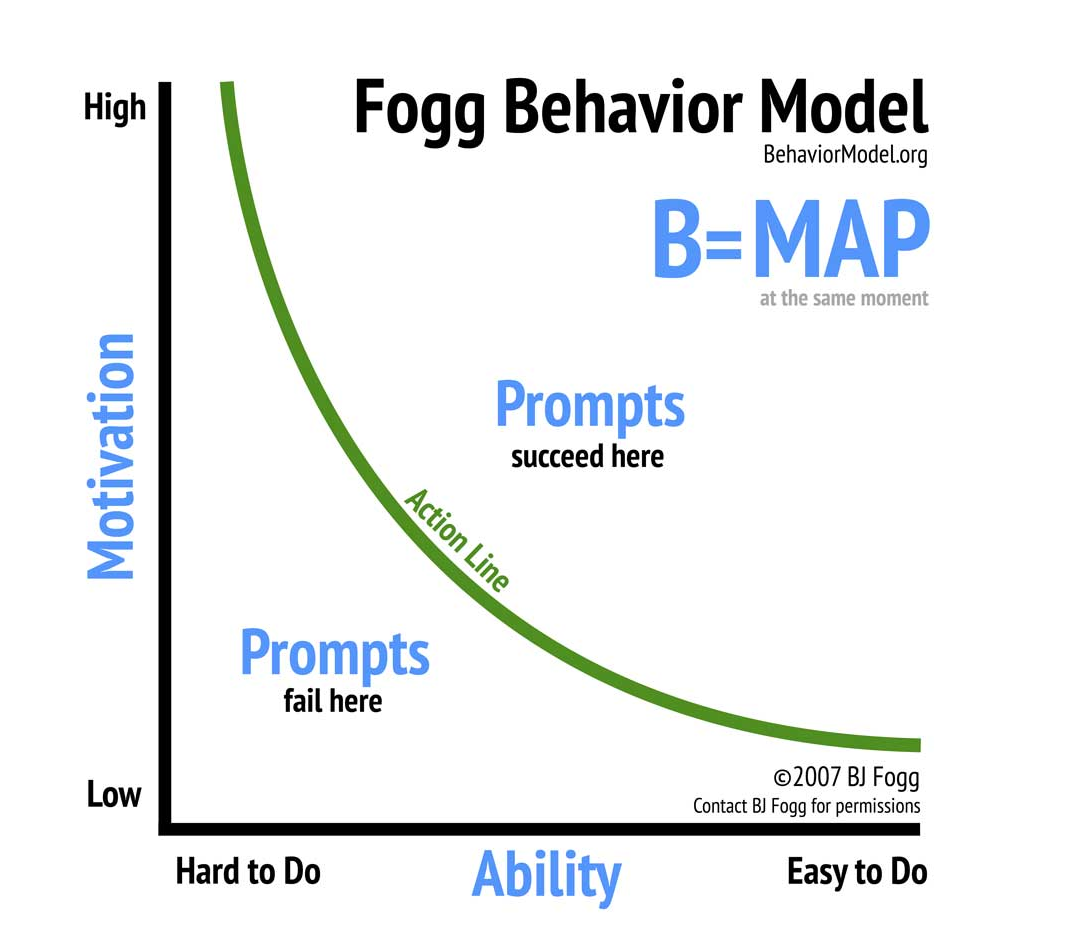As an entrepreneur, you're often working alone, building something new and unique. Without lots of people to reflect back on you, it can be hard to understand your own behaviors and hone them for increased productivity.
I'm currently building Lloyd (which I co-founded with my sister), a startup that brings structure and accountability to careers. I was inspired to write this article when I realized recently that by not understanding my own behaviors (and how to change them), I was missing out on a lot of opportunities. So I set out to change that and improve my path forward.
Exploring behavior change: The Fogg Behavior Model
The Fogg Behavior Model was researched and created by Stanford behavior scientist BJ Fogg (I also highly recommend his book Tiny Habits). This model is intentionally simple, and it's enabled me to understand my own behaviors throughout my work and life (hello, eating habits!). This is especially important when building a startup, where unpredictability is the only certainty.
The formula is: B = MAP.
B: Behavior (what am I doing?)
M: Motivation (do I want to do this?)
A: Ability (can I do this?)
P: Prompt (when do I know to do this?)
Here's how you visualize it. On a graph, motivation is on the y-axis and ability on the x-axis. The higher the motivation (the more you want to do it), the further up you are on the y-axis. The higher the ability (the easier it is for you), the further up you are on the x-axis.
The full graph includes a curve for prompt. The prompt is the thing that alerts you to do a behavior.

For example, let's say that I want to do 10 push-ups every morning. I have high motivation (I want to get in shape), and I have the ability (I can do 10 push-ups). So I now need a prompt (perhaps a daily alert on my phone) to make sure that this behavior happens. I'll talk about the strength of the prompt later in this piece.
Because of the unpredictability of being a small business owner, I find it helpful to create systems like this to quantify (or qualify) what I'm working on. It gives me a sense of structure that I crave—and that's hard to find otherwise. So I took this model and made it my own.
My take on applying the Fogg Behavior Model
First, I divided the graph into a grid with nine sections. This helped me visualize things more easily. Then I started applying some values to motivation (y-axis) and ability (x-axis).
So now I have a rough rating system of motivations and abilities. For example, I'll start with something I'm motivated by: creating a growth plan for my startup. I give it a score of 3 for motivation. I'm less motivated by accounting: it gets a motivation score of 1. A similar process is used for abilities. The greater the ability that I have, the higher the score (further to the right on the x-axis).
To apply these figures, let's multiply them together in the grid. As an example, if a certain behavior has a motivation score of 3 and an ability score of 3, the prompt score would be 9 (3 x 3).
Voilà! I now have a scoring system. By multiplying the motivation score by the ability score, I calculate a prompt score. This represents the strength of the prompt that's needed for the desired behavior to be successful. As defined by Professor Fogg, the top-right prompt (a score of 9) is something simple like an alarm clock or calendar activity. You have the motivation and the ability to do this activity—you just need a little nudge.
So what are the cutoffs for prompts?
A prompt score less than 3 is likely going to fail—or the prompt would need to be very strong. Strong prompts, as described by Professor Fogg and others, likely require considerably more education, more of a stepwise approach (i.e., do this one small action first, then move on), or the presence of a human or other strong motivator (i.e., a personal trainer or coach).
I find that as an entrepreneur, I have a pretty high level of motivation for most activities. This generally rules out that scary 1 prompt score in the bottom-left. But my ability—that's not quite as set in stone.
How to find the right prompts
To start, think about the typical prompts that naturally exist for individuals working in larger office settings or bigger companies:
A manager gives structured assignments and deadlines.
The company leadership outlines broad expectations, priorities, and timelines.
Workers see their peers accomplishing tasks and starting new projects.
There are other stakeholders on projects, so there are likely meetings and other things you're held accountable for.
Of course, as an entrepreneur or small business owner, you probably experience few, if any, of these prompts. You set the priorities, you set the deadlines, and you set the structures. That's why it's so important to set your own prompts.
To put this in context, let's look at how I use prompts to move forward with our goals at Lloyd. I'll outline a few types of prompts and examples of behaviors the prompts may be best applied to going forward. (The lower the score, the stronger the prompt needed for the behavior to be effective.)
Hit monthly goals (3). Hitting monthly goals is highly motivating for me (motivation score of 3) because it's exciting to think about what we'll accomplish over the next month. That said, it's typically a tough exercise (ability score of 1), as hitting stretch goals often requires aligning with many factors (e.g., company finances, investor and customer expectations). That means the prompt needs to be strong and continuous.
Publish daily marketing material (9). Conversely, the prompt score here is 9, meaning it doesn't need to be a strong prompt for this behavior to succeed: I have high motivation and ability for this behavior. A simple prompt, like a calendar reminder, should do the trick.
Analyze recent product usage data (4). I have moderate motivation (the analysis is sometimes exciting, sometimes tedious) and moderate ability (some statistical analysis can start to get outside of my realm of understanding). 2 x 2 = 4, which is a relatively low prompt score, so my prompt is stronger, in the form of a standing meeting.
Complete company administrative work (3). Booking meetings, catching up on emails—this is work that I have the ability to do (score of 3), but I don't love it (motivation score of 1). I often find myself saying, "I'll do this tomorrow." My current prompt of blocking time on my calendar isn't effective, and I'm getting close to the spot where no prompt will really be effective. In this case, I may need to consider automating this work, delegating this work, or re-orienting this work to increase my motivation.
If you're not sure when to automate a task, start here. Then take a look at these 5 things you should automate today.
This is all still a work in progress for me, but I'm excited about how I can continue to implement the B=MAP methodology into my own work as an entrepreneur. I encourage you to think about how it can help you understand your own behaviors: why some come naturally, why you put others off, and how you can make sure you're using all the tools in your toolbox to get things done.
If you're looking for more structure in your work or career, I'm happy to help. Shoot me an email at dan@withlloyd.com with a B=MAP that you want to figure out. Let's discuss! Or, if you're looking for more accountability in your career overall, we work to implement these methods into our work at Lloyd. Come on over and give it a try.





